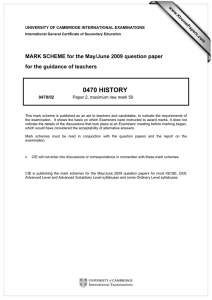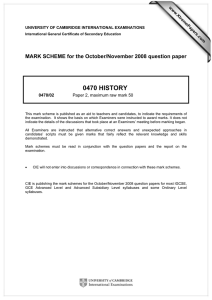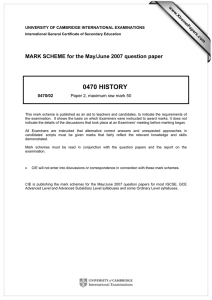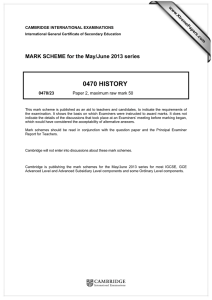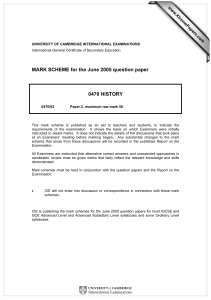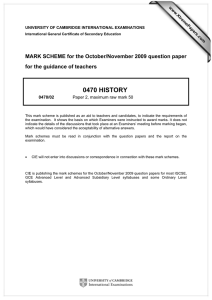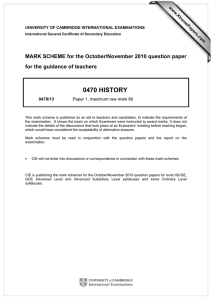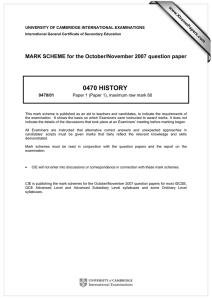0470 HISTORY MARK SCHEME for the May/June 2010 question paper
advertisement
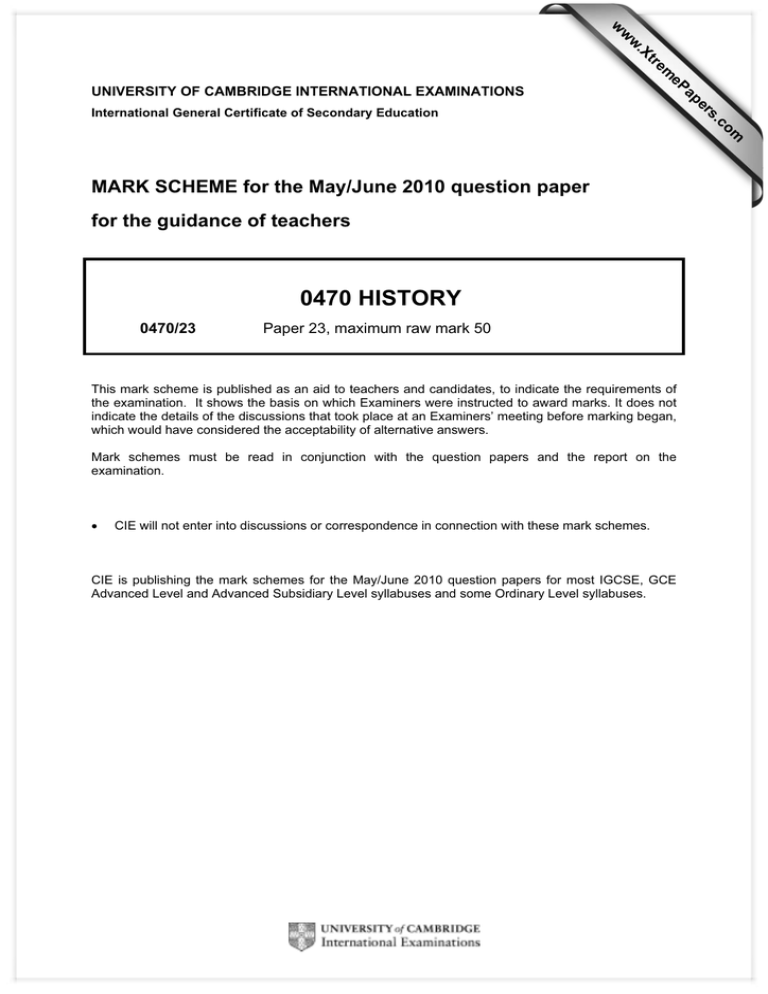
w w ap eP m e tr .X w UNIVERSITY OF CAMBRIDGE INTERNATIONAL EXAMINATIONS for the guidance of teachers 0470 HISTORY 0470/23 Paper 23, maximum raw mark 50 This mark scheme is published as an aid to teachers and candidates, to indicate the requirements of the examination. It shows the basis on which Examiners were instructed to award marks. It does not indicate the details of the discussions that took place at an Examiners’ meeting before marking began, which would have considered the acceptability of alternative answers. Mark schemes must be read in conjunction with the question papers and the report on the examination. • CIE will not enter into discussions or correspondence in connection with these mark schemes. CIE is publishing the mark schemes for the May/June 2010 question papers for most IGCSE, GCE Advanced Level and Advanced Subsidiary Level syllabuses and some Ordinary Level syllabuses. om .c MARK SCHEME for the May/June 2010 question paper s er International General Certificate of Secondary Education Page 2 Mark Scheme: Teachers’ version IGCSE – May/June 2010 Syllabus 0470 Paper 23 19th Century Option DID THE SOUTH HAVE NO CHANCE OF WINNING THE AMERICAN CIVIL WAR? 1 2 Study Sources A and B. How far do these two sources disagree? Explain your answer using details of the sources. [7] L1 Writes about the source(s), but no comparison OR Compares provenance of the sources [1] L2 Different: because something that is in one source is not mentioned in the other [2] L3 Agreements OR disagreements [3–4] L4 Agreements AND disagreements [4–5] L5 Disagreement on the big message i.e. In A the South has a chance, in B it has no chance [6–7] Study Sources C and D. Would John Sidell (Source C) have been surprised by Source D? Explain your answer using details of the sources and your knowledge. [8] L1 Writes about the source(s), no mention of surprise [1] L2 Identifies what is/is not surprising, but no explanation OR Uses undeveloped provenance [2] L3 Matches content for surprise OR not surprise [3–4] L4 Matches content for surprise AND not surprise [5–6] L5 Not surprised: explains the difference in context i.e. because of the changing situation [7–8] © UCLES 2010 Page 3 3 4 Mark Scheme: Teachers’ version IGCSE – May/June 2010 Syllabus 0470 Paper 23 Study Source E. Why was this cartoon published in 1864? Explain your answer using details of the source and your knowledge. [8] L1 Describes the cartoon, no reason given [1] L2 Misinterpretations [2] L3 Message OR Undeveloped purpose It’s for a Northern audience so, e.g. to boost morale [3–4] L4 Context only [5–6] L5 Message and context [7] L6 Purpose explained in context i.e. why would North need reassurance of victory in 1864? [8] Study Sources F and G. How far do the cartoonists of these two cartoons agree? Explain your answer using details of the sources and your knowledge. [7] L1 Describes the cartoon(s), no comparison OR Answers based on provenance [1] L2 Misinterpretations [2] L3 Valid interpretation(s), but no valid comparison OR Disagree: one tells us something that the other doesn’t. [3] L4 Compares sub-messages e.g. South has given up in F, but not in G. [4] L5 Agree on the big message i.e. that the South is in big trouble. [5–6] L6 Agreement on cartoonists’ viewpoints i.e. sympathy/support for the North © UCLES 2010 [7] Page 4 5 Mark Scheme: Teachers’ version IGCSE – May/June 2010 Syllabus 0470 Paper 23 Study Sources H and I. Is one of these sources more reliable than the other? Explain your answer using details of the sources and your knowledge. [8] L1 Writes about the source(s) [1] L2 Uses undeveloped provenance [2] i.e. no valid use of content OR Answers on the basis of the supposed agreement between the two sources on the issue of resources L3 Cross-reference to other sources/background knowledge to judge reliability of H OR I [Note: Source I is not about resources, it’s about Davis] [3–5] L4 Cross-reference to other sources/background knowledge to judge reliability of H AND I [5–6] L5 Evaluation of content using purpose to judge reliability 6 [7–8] Study all the sources. Do these sources provide convincing evidence that the South had no chance of winning the Civil War? Use the sources to explain your answer. [12] L1 No valid source use [1–3] L2 Uses sources to support OR reject the statement [4–6] L3 Uses sources to support AND reject the statement [7–10] Up to 2 bonus marks for any evaluation of sources (one per source). Source use must be reference to a source by letter, provenance or direct quote. There must be examples from source content, and an explanation of how this does/does not support the statement. Use ‘Y’ for each source supporting the idea that the South HAD a chance, and ‘N’ for each that supports the idea that it did not. Y [HAD a chance] N [Had NO chance] Sources: B, D, E, F, G, H (I) Sources: A, C, D, (I) © UCLES 2010 Page 5 Mark Scheme: Teachers’ version IGCSE – May/June 2010 Syllabus 0470 Paper 23 20th Century Option HOW IMPORTANT WAS LECH WALESA? 1 Study Sources A and B. How far do these two sources agree? Explain your answer using details of the sources. [7] L1 Writes about the source(s), but no comparison OR Compares provenance of the sources [1] L2 Different: because something that is in one source is not mentioned in the other [2] L3 Agreements of detail [3–4] L4 Disagreements of detail [4–5] L5 Agreements AND disagreements of detail [6] L6 Explains the big disagreement: e.g. Solidarity is not a big threat in A, it is in B 2 Study Sources C and D. How do you explain the different impressions given by these two sources? Explain your answer using details of the sources and your knowledge. [8] L1 Writes about the source(s), no difference identified [1] L2 Because of (undeveloped) provenance 3 marks only when more than one difference is identified. [2–3] L3 Identifies the different impressions [4–5] L4 Explains why the impressions differ, using C or D [6–7] e.g. Because in C he has access to specific information (not just he was there =L2)/because D is shaped by US Cold War attitudes L5 Explains why they differ, using C and D © UCLES 2010 [8] Page 6 3 Mark Scheme: Teachers’ version IGCSE – May/June 2010 Syllabus 0470 Paper 23 Study Source E. Do you think the authorities were worried by the content of this source? Explain your answer using details of the source and your knowledge. [7] L1 Writes about the source [1] L2 Uses undeveloped provenance [2] L3 Identifies what in the source is/is not worrying, but no explanation why [3] L4 Explains why they would be worried using everyday empathy [4] e.g. because they would be embarrassed by it/because it shows dishonesty/disagreements 4 L5 Explains why, using content and context [5] L6 Explains why, using content and provenance [6] L7 Explains why, using content and status of people saying these things [7] Study Sources F and G. How different are the messages of these two sources? Explain your answer using details of the sources and your knowledge. [8] L1 Describes the cartoon(s), no comparison [1] L2 Misinterpretations [2] L3 Valid interpretation(s), but no valid comparison [3] L4 Valid comparison(s) of sub-messages, similarity OR difference e.g. Free/not free, strong/weak, Walesa important in both [4–5] L5 Valid comparison(s) of sub-messages, similarity AND difference [6–7] L6 Cartoonists’ opinions compared using content [If just asserted, no use of content to illustrate, then award L4/4] [8] © UCLES 2010 Page 7 5 6 Mark Scheme: Teachers’ version IGCSE – May/June 2010 Syllabus 0470 Paper 23 Study Sources H and I. Do these sources prove that Gorbachev was a failure? Explain your answer using details of the sources and your knowledge. [8] L1 Writes about the source(s) [1] L2 Uses undeveloped provenance [2] L3 Uses content to illustrate failure OR not failure [3–4] L4 Uses content to illustrate failure AND not failure [5–6] L5 Evaluates source(s) to decide issue of proof e.g. using cross-reference, purpose etc. [7–8] Study all the sources. How far do these sources provide convincing evidence that Walesa was the crucial factor in developments in Eastern Europe? Use the sources to explain your answer. [12] L1 No valid source use [1–3] L2 Uses sources to support OR reject the statement [4–6] L3 Uses sources to support AND reject the statement [7–10] Up to 2 bonus marks for any evaluation of sources (one per source). Source use must be reference to a source by letter, provenance or direct quote. There must be examples from source content, and an explanation of how this does/does not support the statement. Use ‘Y’ for each source supporting the statement, and ‘N’ for each that does not. Y N Sources: A, B, D, F, G, (H) Sources: A, B, C, E, F, H, I © UCLES 2010
